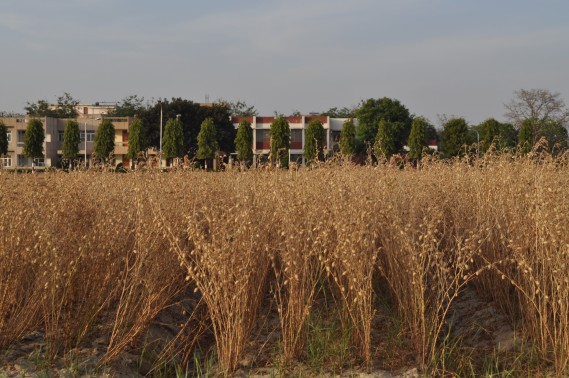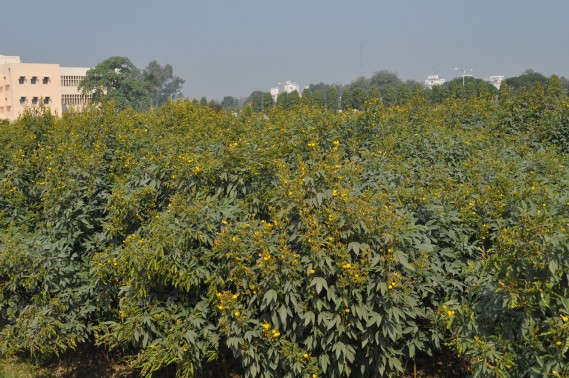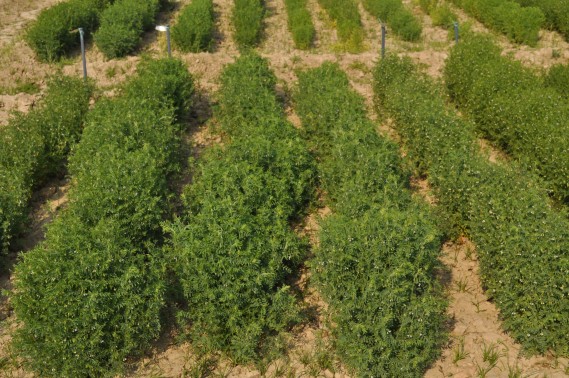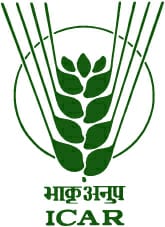Mandate Crops:
Chickpea, Pigeonpea, Lentil, Fieldpea, Urdbean, Mungbean, Lathyrus, Rajmash, Cowpea, Horsegram, Mothbean
Chickpea
Chickpea is an important food legume commodity and have a diverse use with specific consumer preference in the global market. Chickpea production in India has peaked to all time high at 11.23 million tons during 2017-18 (MoAF&W, 2019) and it was sustained to 10.32 million tons (MoAF&W, 2019) which has ushered self sufficiency for this main pulse crop in India. With negligible share of private sector in this crop, this remarkable achievement could be attained with the efforts of chickpea breeders from the National Agricultural Research System (NARS), policy makers at the center and state ministries and personnel of the seed production and certification system. During 2021-22 (fourth estimate), chickpea production of India was 13.75 million tonnes from an acreage of 10.91 million ha. with a productivity of 12.6 q./ha (DES 2023, MOAF&W, GoI). Chickpea solely contributes nearly 50% of the Indian pulse production. States like Maharashtra (25.97% contribution to national production), Madhya Pradesh (18.59%), Rajasthan (20.65%), Gujarat (10.10%) and Uttar Pradesh (5.64%) are major chickpea producing states of India. Chickpea has a diverse consumption pattern in the Indian market. The food products include immature green grain (desi type), mature grain (desi/kabuli type), flour of mature grain (besan, desi type), roasted grain (desi type), flour of roasted grain (shattu, desi type), split grain or pulse (dahl, desi type), snacks (namkeens, desi and kabuli type), flakes (desi type), baked products (from flour, desi type), sweets/savories (from flour, desi type) and various tertiary processed products (cuisines). With the increasing trend of the market of products based on plant protein (protein isolates etc.), importance of chickpea to the processing sector has enhanced further. The global chickpeas market grew from $13.93 billion in 2022 to $14.9 billion in 2023 at a compound annual growth rate (CAGR) of 7.0%. The chickpeas market is expected to grow to $19.19 billion in 2027 at a CAGR of 6.5%. During 2021, INDIA’s share in global Export of chickpea was 5.87% (Rank 5, Export Volume 94.08 MKGs) and share in Import was 12.51% (Rank 2, Import Volume 240.97MKGs). Share of India in in global chickpea Production was 73.46% during 2020 [Tridge, 2023].

Pigeonpea
The pigeon pea production of India was 4.34 million tonnes (leading producer) from an acreage of 5.05 million ha. with a productivity of 859 Kg/ha. (DES, MoAF&W, 2022, fourth advanced estimates). India is the leading importer (92.65% Share in global pigeon pea import in 2021) with an import volume of 674.44 million Kg. India contributed to 77.61% of the global pigeonpea production during 2020 (Tridge, 2023). The global pigeon pea market reached a volume of 13.3 million tons in 202 as per FMI, a market research organization. The market is projected to reach 23.6 million Tons by 2027, exhibiting a CAGR of 9.51% during 2022-2027. In 2022, the estimated market value of pigeon pea (FMI, 2023) is US$ 14,334.5 million which is expected to touch US$ 23,798 million by 2032. Pigeonpea is majorly used a split cotyledons (dahl), and the consumer market is majorly dependent on this product. It’s an indispensable part of the vegan diet of the Indian subcontinent. Besides the pigeon pea crop is immensely important with respect to diversification of the cropping cycle, low ecological foot print, improvement of soil health, bringing fallow lands under cultivation etc. Mozambique is the top exporter of pigeon pea. In India. Uttar Pradesh state is the leading producer (0.47 million tonnes from 0.49 million ha. with a productivity of 944 kg./ ha.) contributing to 34.87% of the national production (Fourth advanced estimates, DES, MoAF&W, 2022). It is followed by Madhya Pradesh (0.44 million tonnes, 34.55% of national production), West Bengal (10.53%), Bihar (8.84%) and Jharkhand (4.53 %) states with respect to their contribution in the national production of pigeon pea

Lentil
Lentil production of India was 1.28 million tonnes in 2022 from an acreage of 1.42 million ha. with a productivity of 904 kg/ha. as per fourth advanced estimate from DES, MoAF&W, Govt. of India. Canada was the top exporting nation for lentil in 2021, whereas India was the top importer. Lentil had an Export value worth US$ 2.80 billion in 2021 and an import value of US$ 2.85 billion. The global lentil market had a volume of 8.30 million tons in the year 2021. The global lentil protein market is expected to reach a market valuation of US$ 208.3 million by 2033, accelerating with a CAGR of 5.1% by 2033 (FMI, 2023). The global lentil market size reached 14.2 Million Tons in 2022. Looking forward, the market analyst firm Tridge expected the market to reach 26.7 Million Tons by 2028, with a CAGR of 11.1% during 2022-2028 (Tridge, 2022). Lentils are rich in carbohydrates, protein, fat, fiber, folate, thiamine, vitamins, minerals, potassium, copper, zinc, iron, and other essential nutrients and used widely in the processing sector (unhusked seeds, split cotyledon dahl, savouries etc.). Lentil is the principal legume crop in the rice fallow belts of eastern India and also taken by farmers of central India. As per fourth advanced estimate from DES, MoAF&W, Govt. of India, 2022- Uttar Pradesh is the leading lentil producing state in India (0.47 million tonnes from 0.49 ha. acreage, 36.43 % of national production), followed by Madhya Pradesh (0.44 million tonnes from 0.49 million ha. acreage, 34.55% of national production), West Bengal (10.53%), Bihar (8.84%) and Jharkhand (4.50%) depending on their contribution in the national production of lentil.

Fieldpea
Fieldpea is another important rabi pulse crop grown in 0.64 m ha with annual production of 0.88 m tonnes during 2020-21. The average productivity of this crop has increased considerably over the years which is now to the tune of 1.4 t/ha. UP, MP, Bihar, Assam and Orissa are the major fieldpea growing states. The pea processed ingredients market has been forecasted to generate a revenue of approx.. US$ 5.0 billion by 2026, at a CAGR of 10.1%. The global field pea industry was expected to be valued at USD 3.1 billion in 2021 (Market Research Future, 2022). Dried Peas Market is worth US$ 5.05 billion in 2023 and is anticipated to reach over USD 7.74 billion by 2028, growing at a CAGR of 8.9% (Market data Forecast, 2022). Field pea has a wide base processed product based consumer market for split cotyledons (dahl), whole seed, different savouries, protein isolates etc.



